Excerpt: Unifier Festival is back after skipping a year in 2017, and this time they have their own venue.
In a recent article, the LA Times said festival producers and promoters are abandoning the bigger is better approach employed by iconic events like Coachella, Lollapalooza, and Bonnaroo. In it, they argued that “After years of expansive growth, some promoters are starting to think smaller, tailoring their offerings to specific audiences” citing oversaturation and a number of festivals that are growing much faster than the pool of talent to book for the show. It seems almost impossible for young, small events to get a leg up unless owning your venue is somehow in the cards.
The Trend to Purchase Land
In a flurry of long-planned acquisitions, several festivals have already announced purchases going through on land they want to own. Some are already ahead of the curve, having owned their venue for years ahead of their peers. Boom Festival, in Portugal, has been an icon of the industry in part because in 2016 they executed one of the most successful crowdfunding campaigns the festival industry has seen yet for a land buy. Now they don’t have to tear down all the art that gets built each year. Instead, they can put that energy – and those funds – into building more art the following year at Herdade da Granja in Idanha-a-Nova (aka Boomland) which only enriches the experience further. Burning Man also recently announced a purchase of Fly Ranch, which made the Guardian. Plus, in Canada Shambhala has benefited by leaving stages assembled on their land, to keep the cost of the events production down. They’ve won over the locals with philanthropic efforts too. Each of these has attendee numbers over 20,000, with Burning Man being closer to 80,000, begging the question: “Is land purchasing only for the big fests or can intimate “boutique” events use a similar strategy to get ahead too?”. While the biggest barrier to land acquisition may be funding, Unifier’s purchase demonstrates that anybody can do it. Perhaps more importantly, their approach also illustrates that a single event need not shoulder the costs alone.
 Collaboration Over Competition
Collaboration Over Competition
Setting out to purchase Camp Timber Trails, was no easy task. Since Unifier only needed the event for a fraction of the year they looked for other event producers that may want to use it during other seasons. It didn’t take long to connect with Dance New England, who head up a community of Ecstatic Dancers. That got them most of the way there but they knew others may want to use the space and the more people could support the purchase the easier it would come to be.
“It’s particularly exciting how many individuals from conscious events are appearing to become support us. Thus far, Forty-four people have come together from two communities arts organizations. One is 39-year old Ecstatic Dance community that also happens to be a 501c3. The other is Unifier Festival!” Says Unifier Festival Founder Jason Cohen.
Through the collaboration, in lieu of competition, both groups also get access to an abundance of wildlife. Moose, Black Bear, Porcupines are just a few of the marvelous creatures that live in the neighborhood year round. As a former Girl Scout Camp, with summer camp vibes and activities to match, participants can look forward to summits with breathtaking views across 417-acres, in addition to a 16-acre lake, complete with Blueberry Island in the middle, which is aptly named for the wild blueberries that exist there. Attendees at both events can look forward to activities like canoeing, kayaking, swimming, while vacationing in style at one of the thirty-nine cabins onsite.
What this means for Festivals
If the purchase is any indication, Festivals are likely to push further in the direction of venue ownership as Live for Live Music’s appropriately termed “festival bubble” gets closer to popping. Just like tiny houses and van life are answers to a collapsing housing market, owning the land will be how festivals go about future survival. We’ll also see more crowdsourcing and collaborative purchases to hurdle the challenges that come with it. For those that successfully make the leap, the year over year enrichment at these events will quickly outrun the goliaths of the industry who pay steep rents on city-owned venues when they could be reinvesting in the fan experience. What’s more, the parties that happen at these events will increasingly be driven to positively impact the venue as well as their locale. Permaculture and other environmental drives will pick up steam to steward the land while feeding those who live on it. Wastestream diversion and “leave-no-trace” ethics will be increasingly critical so that the venues that when a venue becomes “home” it continues to feel like one. It remains to be seen how quickly events will adopt a strategy like that of Boom, Burning Man, Shambhala, and now Unifier. Fortunately, we have plenty of models for the way it might one day be.
For more info on Unifier, check out the Unifier 2018 Facebook Event Page, sign up for the newsletter to stay in the loop or pick up a ticket here. See you there!

